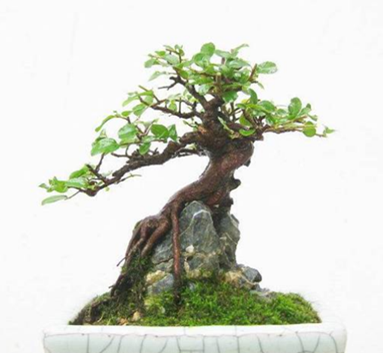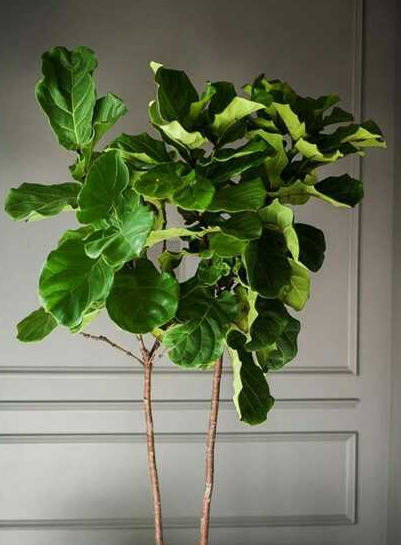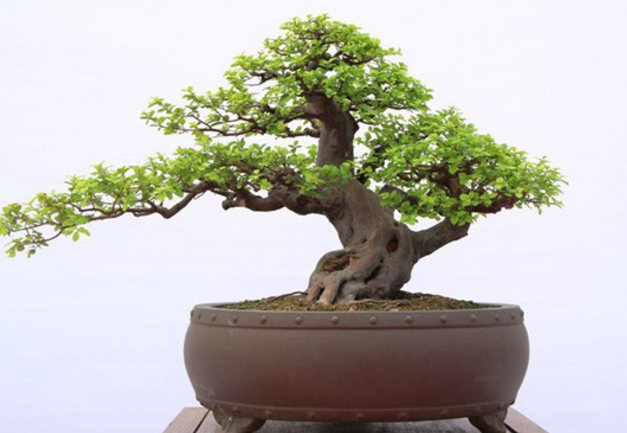How to breed sparrow plum bonsai correctly and how to keep it through the winter
Sparrow plum is a kind of shrub and a high-quality material for making bonsai. It is known as the "seven sages" in ancient China. It is a kind of ancient and dignified tree, mainly produced in the Yangtze River basin and the southeast coastal zone.

How to raise sparrow plum bonsai correctly
1. Watering of sparrow plum bonsai
Finch plum bonsai is suitable for growing in a humid environment, during the growth period to keep the basin soil moist, but not stagnant water, easy to rot roots. Hot weather in summer should be watered more, and at the same time, some water should be sprayed on the leaves and trees to lower the temperature, increase moisture, and reduce watering in winter.
2. The illumination of sparrow plum bonsai
Sparrow plum bonsai is bright but not cold-resistant and should be maintained in a well-ventilated and humid environment. Summer should be properly shaded to avoid exposure to the sun.
3. The temperature of sparrow plum bonsai
Finch plum bonsai is afraid of severe cold. In northern China, it should be put indoors for maintenance after the end of autumn to ensure that the indoor temperature is above 8 ℃. In the south of our country, we can spend the winter in the leeward and sunny place in winter.
4. Fertilization of sparrow plum bonsai
During the growing period of sparrow plum bonsai, thin pancake fertilizer and manure should be applied every half a month. Fertilization management is not required in summer and winter.
5. The turning of sparrow plum bonsai
Finch plum bonsai needs to be turned once in 2-3 years, when it is sprouting from February to March. In order to replace part of the old soil, some base fertilizer can be added at the same time, and the corresponding root treatment can also be carried out.
6. prevention and control of diseases and insect pests of sparrow plum bonsai
Finch plum bonsai is vulnerable to long-leaf moth, longicorn beetles, shell insects, aphids and so on, which can be prevented by spraying phosphos emulsion and omethoate EC. The most direct way is to wash it manually and smear it with stone-sulfur mixture.
How to spend the winter with sparrow plum bonsai
Finch plum bonsai is not cold-resistant, how to maintain it in winter? Especially in the northern part of our country, how can we ensure the safety of sparrow plum bonsai through the winter?
1. Watering of sparrow plum bonsai in winter
Finch plum bonsai should be watered in winter, and natural water is the best, such as river water, Rain Water and so on. If you use tap water, store the water for a day or two, let the chlorine out of the water, keep the water temperature about the same as the indoor temperature, and then water it. Finch plum bonsai has entered a dormant period in winter, and the demand for water is not high, so just pour some water properly.
2. The temperature of sparrow plum bonsai in winter
Finch plum bonsai is not cold-resistant in winter, so it should be maintained indoors, especially in the north of our country. If you are outside, wrap it with a thin film. You can uncover the film every two days when the temperature is high at noon to let the sparrow plum breathe.
3. Humidity of sparrow plum bonsai in winter
Finch plum bonsai likes a humid environment, it is best to keep the air relative humidity at 70-80%, the air relative humidity is too low, the lower leaves are yellow and fall off, and the upper leaves are dull. In northern China, there is heating indoors in winter, and it is relatively dry indoors, so it is necessary to spray water to the leaves to maintain the wetness of the environment.
4. the light of sparrow plum bonsai in winter
In winter, to maintain sufficient sunshine in winter, try to put sparrow plum bonsai in places with better light, such as living room, bedroom, study, balcony lamp place. After maintaining indoors for a period of time, move it to an outdoor shaded place for maintenance for a period of time, and then move indoors.
5. Fertilization of sparrow plum bonsai in winter
Finch plum bonsai in the winter dormancy period, the growth is basically stagnant, the requirement of fertilizer is not high, do not need to apply fertilizer.
Maintenance knowledge and picture collection of sparrow plum bonsai
Since ancient times, because of people's awe and kindness to nature, people always have special feelings for all kinds of plants of natural creation, and in recent years, with the popularity of plant decoration in home life, all kinds of plant bonsai are highly concerned by more and more people. Finch plum bonsai is one of the most famous bonsai in China for a long time, which is known as the "Seven Sages". So how to maintain the sparrow plum bonsai? Next, let's take a look at the pictures of sparrow plum bonsai and learn about the maintenance knowledge of sparrow plum bonsai.
Maintenance knowledge of sparrow plum bonsai
1. Soil: sparrow plum is a unique tree species, and plants usually grow in wild areas, so the roots of plants are relatively developed, and problems can easily occur if they are slightly improperly maintained. therefore, it is best to choose acidic or neutral calcareous soil in the soil, the soil can be put more appropriately during the culture period, and the new soil needs to be changed every two days.
2. Temperature: sparrow plum actually does not have a particularly high requirement for temperature, but the cold tolerance of plants is really poor, so bonsai culture in winter needs to be kept indoors in a mild place and keep warm.
3. Lighting: sparrow plum likes semi-overcast light, but plants also need enough light to grow healthier, but in summer with strong light, they still need to keep at least 50% shade for bonsai. The place where the indoor light is good is where the bonsai can be big, but you can bask in the sun more in winter.
4. Watering: plants need enough water to grow normally. The water of sparrow plum bonsai is usually drinking water or natural water such as Rain Water. If there is only tap water, you need to store it in plastic for a day before watering.
5. Fertilization: sparrow plum fertilization is very fastidious, if the fertility is too heavy, the plant will grow branches and leaves, if the fertility is not enough, the plant will be weak and yellow, so fertilization needs to be carefully grasped. In spring and summer, plants need to apply more fertilizer, so it is necessary to reduce fertilizer appropriately in autumn, and stop fertilizing after winter.
6. Pruning: since the sparrow plum bonsai is a bonsai, the appreciation of its plants is very important, so in order to maintain the beautiful shape of the bonsai, it is necessary to prune all the time to remove the overgrown and yellow branches and leaves of the plants.
Picture appreciation of Finch Plum Bonsai production
1. Picture of sparrow plum bonsai
Finch plum bonsai is a very elegant plant bonsai, and bonsai and most plant bonsai are the same, its shape and style are varied. But most of the sparrow plum bonsai look very quaint and natural, the green leaves sway gently with the wind on the sturdy branches, and the bonsai is natural, comfortable and beautiful. In fact, most bonsai have a natural flavor, but this kind of sparrow plum bonsai gives people a particularly strong sense of green, probably because the plants have a whole body of green, very natural and comfortable.
2. Sparrow plum bonsai picture 2
Now people light decoration heavy decoration, such bonsai is not only the shape of the simple and elegant, but also belongs to the vitality of plants, making the bonsai has a lot of plants can not match the decoration. Therefore, when the sparrow plum bonsai is put indoors, its decorative effect is very unexpected. In addition, Finch plum bonsai tree trunk is natural and strange, bonsai plant tree posture is vigorous and quaint, it is indeed a very high-grade plant bonsai, put indoors can improve the quality of the room.
Conclusion: Finch plum bonsai is a very famous bonsai in China, and it has been loved by people since ancient times, so if you like it, you might as well raise some.
How to raise potted rose and how to cultivate it
Rose is a kind of flower that can bloom all the year round, its flower color has red, pink, white, yellow and other colors, a plant with high ornamental value. And the origin status of the rose in China, its flowers are beautiful and varied, often bloom at 04:00, deeply loved by people, is one of the top ten famous flowers in our country. Today, let's take a look at how potted rose is raised and how it is cultivated. Rose is known as the queen of flowers, is an evergreen, semi-evergreen low shrub, the four seasons bloom, its flowers are red, pink, yellow and white and other different colors, can be used as an ornamental plant, but also a plant of medicinal value. The flowering period of rose is from August to April of the following year. The flowers are large, divergent from inside to outside, with strong aroma. The adaptability of rose is very strong, relatively hardy, no matter whether it is ground or potted. How to raise potted rose when potted rose is planted, the flowerpot is more important to it. Generally, the size of the flowerpot should be commensurate with the plant size, and the flowerpot should not be too small. When the plant of rose grows up to fill the flowerpot with the rhizome, it is necessary to change the flowerpot in time to meet its rhizome to continue to develop. During the planting period, to maintain sufficient light and ventilation of the rose, when the temperature is relatively high, it should be shaded to a certain extent. Especially when there is a large amount of hot evaporation in summer, potted rose flowers should be watered every day and should be fully watered in the evening. However, it is important to pay special attention to the fact that when watering, do not accumulate water. In the middle of summer, there is no topdressing, but only thin fertilizer is applied to the strong plants, 1-2 times a week. Potted rose culture method soil: when potted rose is carried out, it is best to choose sandy soil rich in humus and slightly acidic and fertile, not alkaline soil. It can also be cultivated with garden soil: rotten leaf soil: Rice chaff ash at the ratio of 5:3:2. Lighting: Chinese rose is a light-loving plant, so there should be plenty of sunshine in its growing season, with at least 6 hours of light every day. If the light is not enough, it will only grow leaves but not blossom, even if it bears buds. The flowers are not colorful and have no fragrance. Watering: it is very fastidious when watering rose flowers. The rose flower is afraid of flooding, so there can be stagnant water in its potted plants. if you water it once a day at most in summer, you can water it when the surface of the pot soil turns white. Winter dormancy period must be less watering, keep semi-wet. Fertilization: rose like fertilizer, in the pot, to fertilize frequently, miscellaneous its growing season, to water light waste water every ten days, no matter what fertilizer is used, are not high excessive use, in order to prevent fertilizer damage, harm the seedlings. When the rose is dormant, stop fertilizing it. Temperature: rose is a plant that likes a cool and warm climate. It is afraid of high temperature, and its growth temperature should be 18-28 ℃. If the temperature exceeds 32 ℃, its flower bud differentiation will be inhibited. Therefore, the rose does not blossom in the case of high temperature in summer, generally a small number of flowers will blossom, its design and color is not as good as those blooming at a suitable temperature. Change the pot: the potted rose should change the potted soil before the new buds sprout in spring every year, in order to facilitate its exuberant growth, and the soil change will help the season bloom in the same year. It can also be carried out before and after overwintering every year to turn the basin, trim the root, change the soil, and increase the basin diameter year by year, with the mud tile basin as the best. Conclusion: the flowering period of rose is very long, so its ornamental value is relatively high. When used in potted plants, the flowers are very beautiful. The above is the introduction of how to raise potted rose and the breeding method of potted rose brought by Xiaobi. after reading the introduction of Xiaobian, I believe we all have a certain understanding, and we can also raise some potted roses at home. In its flowering season, it is of great ornamental value. ▌ related recommendation ☑ cervical vertebra pillow ☑ office carpet ☑ cartoon wallpaper ☑ magnetic paper-cut ☑ Pushu bonsai ☑ computer embroidery ☑ Su embroidery tutorial ☑ bonsai appreciation ☑ sparrow bonsai ☑ safety floor mat
- Prev

How can the cultivation methods and precautions of Qin Ye Ficus be correctly reproduced?
Ficus lutea is an evergreen tree, very tall, suitable for viewing in the hall foliage plants. Mainly produced in the southeast coastal zone, it is a kind of plant that likes moisture very much. Ficus cultivation methods and precautions Ficus cultivation basic needs, light: Ficus like sufficient light environment
- Next

What are the common insect pests in the making methods of sparrow plum bonsai?
Finch plum bonsai is one of the seven sages of bonsai in China and one of the five famous trees in Lingnan bonsai. Sparrow plum also known as shredded rice, thorns frozen green, diagonal thorns. What are the methods of making sparrow plum bonsai? what is the production time of sparrow plum bonsai? the production time of sparrow plum bonsai is carried out in March and Meiyu season every year.
Related
- Fuxing push coffee new agricultural production and marketing class: lack of small-scale processing plants
- Jujube rice field leisure farm deep ploughing Yilan for five years to create a space for organic food and play
- Nongyu Farm-A trial of organic papaya for brave women with advanced technology
- Four points for attention in the prevention and control of diseases and insect pests of edible fungi
- How to add nutrient solution to Edible Fungi
- Is there any good way to control edible fungus mites?
- Open Inoculation Technology of Edible Fungi
- Is there any clever way to use fertilizer for edible fungus in winter?
- What agents are used to kill the pathogens of edible fungi in the mushroom shed?
- Rapid drying of Edible Fungi

